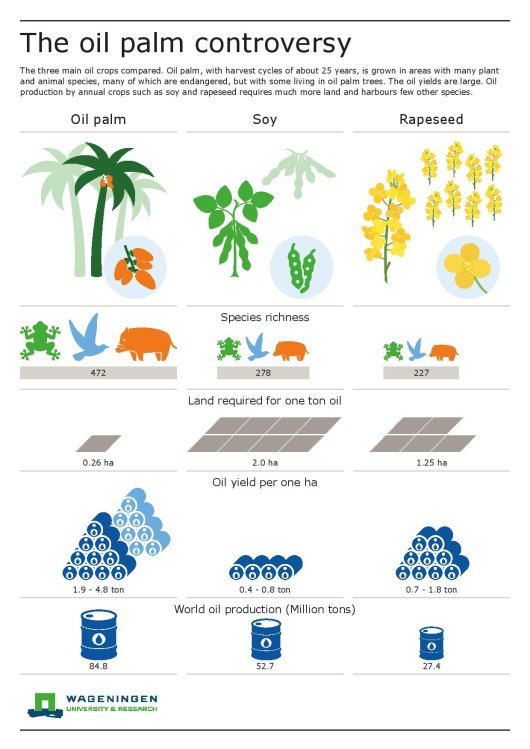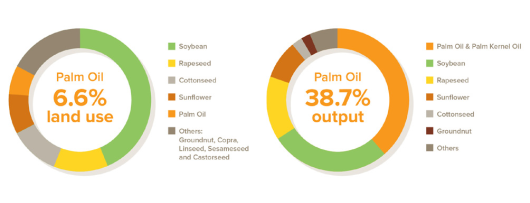It all appeared very clear. The production of palm oil is harmful to the environment and species such as the orangutan, due to deforestation, fires and cultivated peatlands. If we must consume plant-based oils, it would be better to use crops such as olive, sunflower, rapeseed and soybean. A new study by researchers from seventeen countries across six continents published in the scientific journal Nature Plants shows it is not that simple. 'In the Netherlands, we are quick to point at other countries'.
The publication in the journal Nature Plants provides an overview of the environmental and biodiversity effects of palm oil and compares these to other oil-rich crops such as rapeseed, soybean, cotton and sunflower. The research team's most striking conclusion is that while we are relatively well-informed about the impact of palm oil production, we know very little about that of the other crops. As a result, discussions on the comparative sustainability, and relative merits, of plant-based oils are moot unless we have better insight into the effects of their production.

Alternative oil-producing crops disregarded
The significant adverse impacts of complex tropical rainforests being replaced by oil palm monocultures are widely known, says research leader prof. Erik Meijaard of Kent University. 'This is shown in the steep decline of the number of plant and animal species that inhabit oil palm plantations, the emission of greenhouse gasses such as carbon dioxide and methane, changes in the regional climate, pollution of waterways and smoke and smog in cases where burning occurs. That oil palms are in the picture is justified, but at the same time, the effects of other crops may have been disregarded. This begs the question how severe the impacts of other crops such as soybean and rapeseed are, and we have strong indications that these are also problematic in a sustainability context'.
Deforestation by oil palm not the only concern
The study shows that environmental impacts are not unique to the oil palm and that all oil-producing crops have negative consequences. The estimated 21.5-23.4 million hectares of oil palm (approximately five times the area of the Netherlands) are responsible for less than 5% of the global deforestation. But, the impact varies strongly between regions: 3% in West Africa to 47% in Malaysia. This is similar to the deforestation caused by the five times larger area (124 million hectares) of soybean plantations in the world, and both are far less than livestock farming, the leading cause of global deforestation.
The cultivation of rapeseed requires more artificial fertiliser and causes a much higher carbon dioxide emission per volume of oil produced than oil palms. Moreover, the production of coconuts for their oil impacts tropical and sub-tropical biodiversity. To what degree is yet unknown. The fact that oil palms are perennial crops while other oil-producing plants are annual crops, also means that more multi-year studies have been conducted on the effects of oil palms, which is reflected in the number of reports.
| Oil crop | Oil production (million tonnes per year) | Area (million hectares) | Oil yield (tonnes per ha) | Species diversity* |
| Oil palm | 84.8 | 22.5 | 1.9-4.8 | 472 |
| Soybean | 57.2 | 123.9 | 0.4-0.8 | 278 |
| Rapeseed | 27.4 | 35.5 | 0.7-1.8 | 227 |
| Sunflower | 19.9 | 26.5 | 0.5-0.9 | 189 |
| Peanut | 5.9 | 28.2 | 0.5-0.8 | 351 |
| Cotton | 5.3 | 32.1 | 0.3-0.4 | 299 |
| Coconut | 3.6 | 12.3 | 0.4-2.4 | 317 |
| Olive | 3.4 | 9.7 | 0.3-2.9 | No data |
* Number of amphibians, mammals and birds on the IUCN Red List that occur in the area where the oil-producing crop is cultivated.
Take responsibility
The heated debates on palm oil mostly focus on preventing further deforestation and loss of species in countries such as Indonesia and Malaysia, according to co-author emeritus prof. Herbert Prins of the Wageningen University & Research Animal Sciences department. 'But, we must also take responsibility for the issues related to future agricultural production. The state of nature in the Netherlands is poor, and the restoration of nature merits attention. Only by considering the production of plant oils in the larger context of sustainability on a global scale, can we make meaningful plans to meet the future demand. Pointing at other countries is easy if we cannot see the beam in our own eye.'
2 to 8 times more oil from oil palm
It is crucial that we are aware of the negative impact on humans and the environment of the different oil-producing crops, says co-author prof. Douglas Sheil, affiliated to the Norwegian University of Life Sciences in Ås, Norway. 'The oil palm yields much more oil than other crops, as much as two to eight times more per hectare than rapeseed, soybean, peanut, coconuts or sunflowers. As long as the demand for plant-based oils in our food, animal feed, bio-diesel and other products continues to rise, we will be seeking options to step up production. Plant-based oils are a daily consumer good in food and soaps. Reducing demand is no easy task.'

The study shows the importance of considering relative yields of different crops for meeting future oil demand. If oil palm is used as the main crop to meet the predicted demand for plant-based oils in 2050, it will require some 36 million additional hectares of land. If soybean is chosen instead, this would require 204 million extra hectares of farmland. 'These simple calculations do not take into account that each of the oils has unique properties and cannot be simply substituted,' prof. Prins states. 'And, the social aspects such as employment created by the different oil-producing crops, should also be taken into account. Discussions on sustainability must include such optimisation issues.'
Another omission in the optimisation issue is the possible role that micro-algae and other single-celled organisms could have as a new source of oil. 'There are significant developments in this area', says prof. Meijaard, 'but the scale of production is not yet suited to compete with the current oil-producing crops. However, much can change.'
The authors realize that the public debate about especially oil palm impacts has often been emotional. In order to promote global sustainable development goals, however, they argue that we need to reduce the rhetoric and apply science for more nuanced and transparent examination and policy-making. As prof. Prins states, 'we need more facts and figures from the other oil sources and their impacts to meaningfully determine how to best meet the oil demand of the future.






